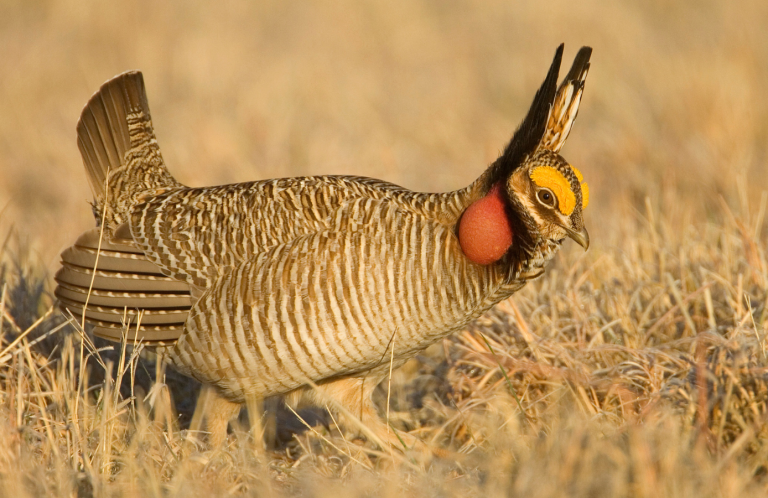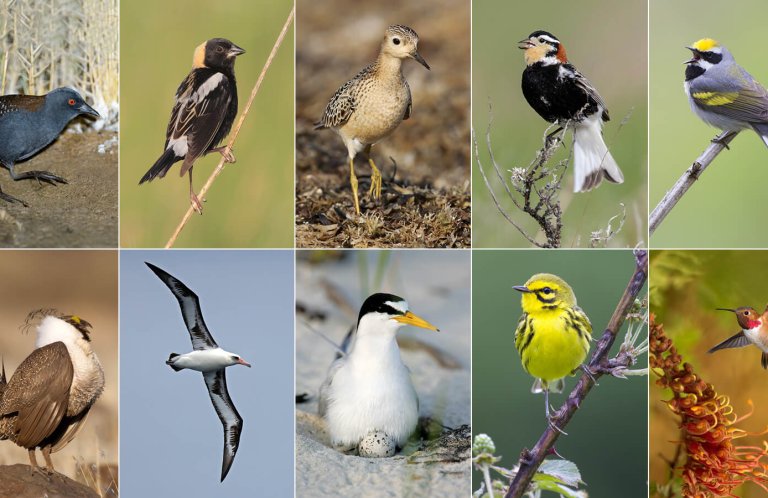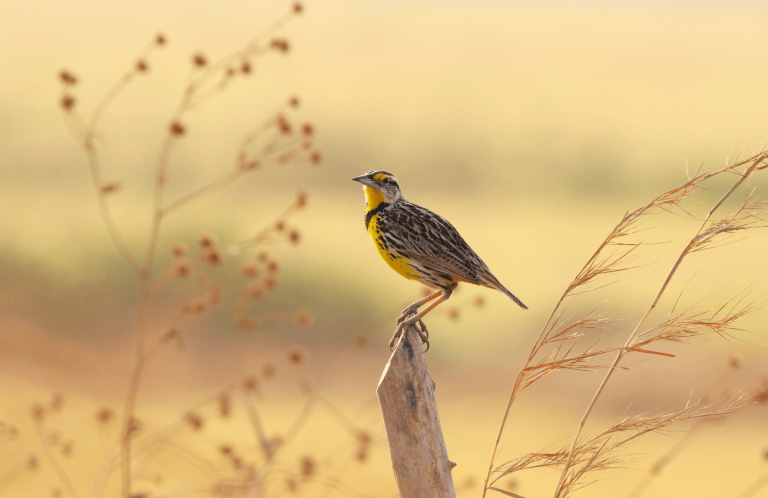This Year's Farm Bill Could Be a Game-Changer for the Most Imperiled U.S. Land Birds

North America's grassland birds are disappearing at an alarming rate, with many considered to be at a conservation “tipping point.” One of the surest ways to turn the tide in their favor could be a sweeping piece of agricultural legislation known as the Farm Bill, which happens to be the single-biggest source of conservation funding in the world. The current Farm Bill expires in September 2023, opening the door for new and stronger conservation measures in the next iteration of the bill.
American Bird Conservancy (ABC) is advocating for measures to be included that have the best chance of saving U.S. grassland bird species from extinction. The recommendations included in ABC's “Bird Saver" platform, outlined below, would help the Farm Bill channel funds designated for conservation to the programs that would make the biggest difference for grasslands.
A Grim Time for Grasslands
Once, grasslands including tallgrass, mixed-grass, and shortgrass prairie stretched across most of the central United States, covering hundreds of millions of acres. These grassland ecosystems supported an incredible diversity of life. Now, after years of agricultural expansion that has seen grasslands replaced by farming and other uses, these precious habitats are in danger of disappearing.
The tallgrass prairies that covered states like Illinois, Iowa, and Missouri have been hit hardest. In these wetter and more lush prairies, plants support a wide range of pollinators and birds like the Bobolink and Eastern Meadowlark, while their extensive root systems stabilize the soil and store huge amounts of carbon.
Today, most tallgrass prairies have been converted into crops like corn and soy, which support just a tiny fraction of the species that once lived there. Things have gotten so dire that this kind of grassland is considered one of the most endangered ecosystems on the planet, with just 4 percent remaining.
“There's still this pervasive notion that grasslands are wasteland and should be converted to cropland, but the truth is, not much lives in a cropland. By design, nothing else can thrive there,” said Steve Riley, ABC's Director of Farm Bill Policy.
The shortgrass prairie of the western U.S., which is dryer and better suited to rangeland than cropland, have fared better. About half of these grasslands remain. Working rangelands can still provide excellent habitat for grassland birds and other wildlife when they use management strategies like planting native grasses and using rotational grazing.
But in recent years, many ranches in the West have been converted to croplands due to economic pressures. In 2021 alone, an area of grassland equivalent to the size of Yellowstone National Park was replaced with row crops. The situation is disastrous for grassland species.
Studies have shown that as grasslands have disappeared, birds have as well. Since 1970, more than half of all grassland birds have been lost. For birds that historically relied on tallgrass prairie, the situation is even more severe — Eastern Meadowlarks are down to just one quarter of their 1970 population.
That's why ABC is focusing on advocating for measures in the upcoming Farm Bill that would keep as much native grassland around as possible, including keeping rangelands as rangelands out West. In the Midwest, measures that incentivize setting aside some acres of cropland for native plants could be a promising way to ensure tallgrass prairies don't disappear.
The Farm Bill's Role in Grassland Conservation
The Farm Bill's history goes back to the Dust Bowl of the 1930s, which was a devastating time for the nation's farmers. It was also a wake-up call regarding the ecological consequences of plowing up the country's prairies, with their thick root systems that kept the soil in place. Since its early days, the Farm Bill has included some kind of conservation provision, originally to help rebuild depleted cropland, though the conservation aspect has changed over time.
In its current iteration the Farm Bill has twelve “titles,” each acting like their own separate bill. Title II deals with conservation measures. Conservation is only a small part of the overall Farm Bill, but it still receives billions of dollars in funding collectively each year, much of which is funneled towards farmland. Conservation measures have typically involved incentivising farmers and ranchers to set aside parts of their land to “rest” for certain periods of time.
Congress passes an updated version of the agricultural-related legislation package every five years or so, and each time it comes up for a vote is a new opportunity to improve upon the last version of the bill.
ABC's Bird Saver Platform: Strengthen Programs Known to Make a Difference
ABC has three key recommendations to strengthen the conservation section of this year's Farm Bill. One of these involves expanding one of the Farm Bill's most historically effective conservation efforts, called the Conservation Reserve Program (CRP). Biologists know that CRP works when properly implemented and enforced, because it has had a measurable impact on certain bird populations in the past.
CRP is a program that was written into the 1985 Farm Bill due to concerns about erosion, largely in the Great Plains. Then as now, farmers agreed to set aside ecologically sensitive land and plant native grasses and other groundcover in exchange for a financial incentive. The end result is a benefit for wildlife benefits and decent income for farmers.
Between the mid-90s and early 2000s, the focus of CRP switched more to the cornbelt — the historic home of tallgrass prairies — and the total number of acres enrolled in the program peaked.
During that same time, grassland bird populations that were declining began to noticeably recover. Henslow's Sparrow and Bobolink numbers both increased as more acres were set aside. For Henslow's Sparrows, about 15 years' worth of declines were reversed in just a third of that time.
Sadly, since 2006, the number of acres of farmland enrolled in CRP has shrunk, and both species are declining again. The good news is that investing in CRP is a tried and true solution, and Congress could expand the program once again this year.
ABC recommends increasing CRP enrollment to 70 million acres — more than doubling its current size, providing habitat for ground nesting birds to safely lay their eggs and a source of food and cover for a wide variety of grassland species. The Inflation Reduction Act was unable to grow CRP as it did with other conservation programs, but the Farm Bill could make this a reality.
Going hand in hand with expanding CRP, ABC also recommends expanding funds for technical assistance to farmers looking to implement conservation strategies. NGOs can work with farmers to maximize the benefit of CRP and other programs involving native habitat, and the new Farm Bill can make it easier to connect the two groups.
ABC's Bird Saver Platform: Add a New Program Dedicated to Resting Land
The organization is also advocating for a brand-new addition to the conservation section of the Farm Bill, called Rest-Restore-Recapture. This would be targeted specifically at ranchers, incentivizing them to let parts of their grazing lands rest for a period of time, rather than continuously grazing cattle on all of their land. Since rest can also be achieved under current Farm Bill authorities, ABC is also calling for stepping up efforts within those programs. Either or both of these solutions can provide a boon for birds.
Approximately 30 percent of the U.S. is rangeland, mostly in the West, which still contains hundreds of thousands of acres of shortgrass prairie. Rangelands are highly diverse, and provide livestock foraging areas and habitat for many wildlife species. Healthy rangelands provide conservation services, including carbon storage, water filtration, erosion control, and nutrient cycling. They are vital to recovering grassland bird populations in the West.
Periodic rest has a number of benefits, for ranchers and birds alike. It improves plant species diversity, soil stability, and resilience to extreme weather. It also increases the land's stored carbon and soil health, and helps grass grow back fuller and richer for cattle. Incentivising a rotational grazing system would be a win-win situation for western grasslands and the ranchers who manage these lands.
“We've got lots of land in the West that's never been plowed and still has a basic natural soil structure and native plants,” Riley said. “A lot of making that work better for wildlife is just being nicer to it. If we take some of the pressure off of it, it'll heal itself.”
Grassland Birds Need Our Help
Nearly 3 billion birds have disappeared from the U.S. and Canada since 1970. Of those, 720 million have been grassland species. Most of these birds' remaining habitat exists on working lands across the central and Western United States. This year's Farm Bill will be a prime opportunity to reward landowners for practices that stop the decline of grasslands and restore habitat that these birds need to thrive.
You can speak up for a stronger Farm Bill by signing ABC's Farm Bill Action Alert.
###
American Bird Conservancy (ABC) takes bold action to conserve wild birds and their habitats throughout the Americas. Inspired by the wonder of birds, we achieve lasting results for the bird species most in need while also benefiting human communities, biodiversity, and the planet's fragile climate. Our every action is underpinned by science, strengthened by partnerships, and rooted in the belief that diverse perspectives yield stronger results. Founded as a nonprofit organization in 1994, ABC remains committed to safeguarding birds for generations to come. Join us! Together, we can do more to ensure birds thrive.
Media Contact
Jordan Rutter
Director of Communications
media@abcbirds.org


















































